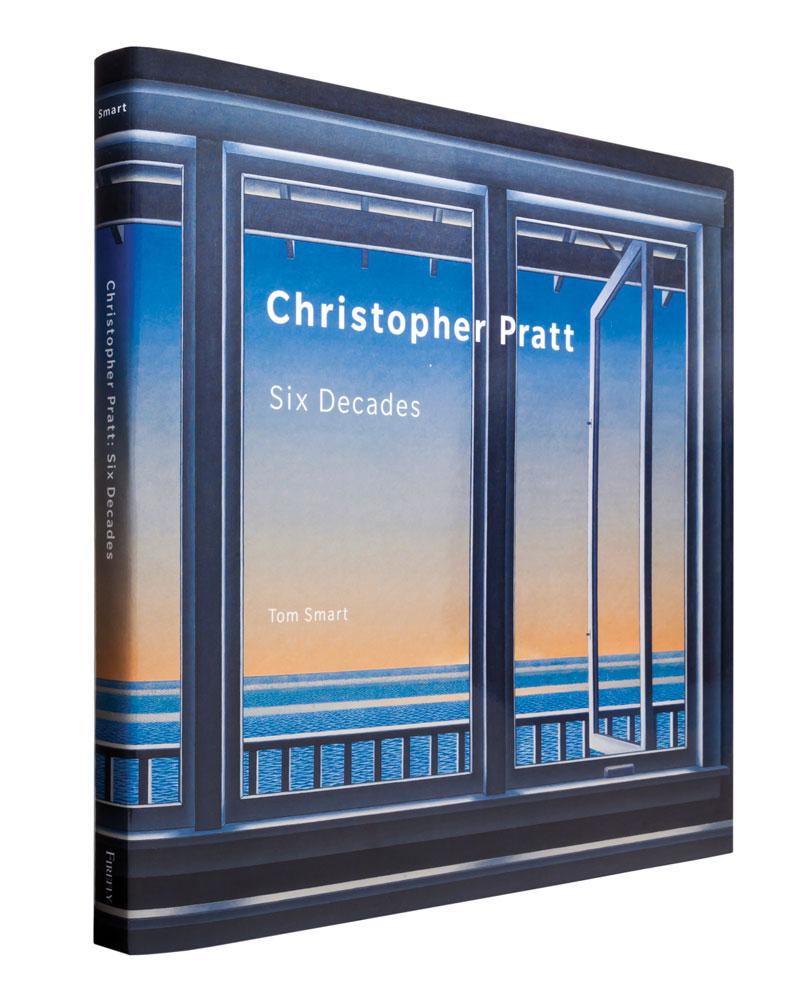Winter is a time for books, and we’ve got some terrific titles to add to your reading list. Among them is a sizeable, enchanting tome about Christopher Pratt’s paintings; a 1963 art-school classic recently re-released, in glorious form, for the iPad; and a glimpse into the mind of Hans Ulrich Obrist.
Christopher Pratt: Six Decades by Tom Smart (Firefly Books) 176 pp, $60.00.
Blending vivid descriptive writing with a solid historical background, Tom Smart gives us an accessible yet nuanced account of Christopher Pratt’s life and practice. The sizeable book dedicates a generous number of pages to high-quality reproductions of some of Pratt’s best-known works. His recurring themes—clapboard houses, female nudes, empty rooms, boats, interior windows and the Maritime landscape—appear throughout and highlight his technical mastery in oil paint. Large reproductions of early works, serigraph prints, watercolours and studies draw closer attention to the more abstract and atmospheric qualities of Pratt’s work. Despite Pratt’s close association with magic realism, often regarded as the polar opposite of abstraction, Smart makes a convincing argument for the formalist qualities of the artist’s work, emphasizing the ways in which his intimate understanding of his subjects governs the composition and laborious making of his works. Alongside the anxiety, emptiness and quiet of Pratt’s paintings, Smart reveals an enchanting, wondrous, meticulous and personal world.
Interaction of Color by Josef Albers (Yale University) app for iPad, $9.99.
First published in 1963 as a 19-pound limited edition two-volume box set, Josef Albers’s Interaction of Color has since seen numerous iterations in its print life. The book is a mainstay of art school colour theory classes and, while the paperback editions have lessened the optical intensity of the original illustrations, the book continues to set a mark for building sensitivity to the chameleon-like life of interactive colour. What a treat, then, to see the original intensity of Albers’s screenprinted examples more than restored in this new iPad edition. Now backlit and gorgeous, Albers’s exercises have never been more vivid—or playful. This is more than a book. It is a toy that delivers hours of instructive fun.
Critical Laboratory: The Writings of Thomas Hirschhorn edited by Lisa Lee and Hal Foster (MIT Press) 417 pp, $40.00.
Hirschhorn recently wound up his series of installations devoted to key philosophers (including Spinoza, Deleuze and Bataille) with Gramsci Monument, a makeshift, event-filled “village” built at a city housing project in the Bronx. Widely praised for its heady engagement with everyday politics and publics, as well as its wry upending of commodified art, the work makes a perfect touchstone for this 20-year survey of essays and images by the Swiss artist, who Peter Schjeldahl has called “the most meaningfully independent of contemporary artists.”
Hans Ulrich Obrist: Think Like Clouds by Hans Ulrich Obrist (Badlands Unlimited) 228 pp, $39.95.
The peripatetic curator Hans Ulrich Obrist is a compulsive note-taker. Over the past 22 years, he has scrawled, sketched and scribbled on hotel stationery, printouts of speeches and torn scraps, creating clustered cloud diagrams out of names, words and dates. He adorns these notes with frenetic loops, spiralling vortices, oblong boxes and flicking arrows. A curated collection of these drawings is presented in Think Like Clouds. It provides a glimpse into the thinking process of one of contemporary art’s most frenzied, boundlessly curious and arguably too-clever minds.
Seeing is Believing: The Politics of the Visual by Rod Stoneman (Black Dog Publishing) 192 pp, $29.95.
Rod Stoneman used to be a commissioning editor for British broadcaster Channel 4, and his new book accordingly evinces a televisual aesthetic, recalling both Marshall McLuhan and John Berger with its short, intuitively connected and cleverly illustrated series of essays. The topics covered are broad, amounting to a fairly comprehensive (if often highly subjective) volume on image theory and literacy. Indeed, with its multiplicity of facts, use of the first-person plural, lucid design and footnoted theorists, it could easily double as a first-year media studies textbook.
Shopping in Jail: Ideas, Essays, and Stories for the Increasingly Real Twenty-first Century by Douglas Coupland (Sternberg Press) 92 pp, $14.00.
This brief collection of recent essays (many of them pertaining or referring to visual art) begins with a preface by Shumon Basar entitled “Douglas Coupland, A to B” and ends with the line, “But, of course, that’s just my ego speaking.” Coupland’s prolific, pronounced “I” is thus to be expected, and this mostly works in the book’s favour as it takes on such diverse topics as dumpster diving with Stephen Dorff, the Chinese economy, sex in “the new information world,” Marshall McLuhan and Ed Ruscha.
Giorgio Morandi by Maria Cristina Bandera, Marco Franciolli et al. (Silvana Editoriale) 288 pp, $60.00.
Bandera quotes Paul Auster’s Sunset Park—”She thought the delicacy of her touch could lead her to the sublime and austere realm that Morandi had once inhabited. She wanted to make pictures that would evoke the mute wonder of pure thingness….”—as an example of Morandi’s continuing relevance to contemporary sensibilities. Her thoughtful book serves as the catalogue to the Morandi survey exhibition that toured Europe this past year. Aside from great reproductions of the paintings, the book includes a range of impressive photos of the painter’s bedroom studio by Italian photographer Gianni Berengo Gardin and a wide range of “appreciations” by figures such as American artist Lawrence Carroll and Italian filmmaker Bernardo Bertolucci.
This is an article from the Winter 2014 issue of Canadian Art. To read more from this issue, visit its table of contents, or buy a copy on newsstands, the App Store or Zinio until March 14.









